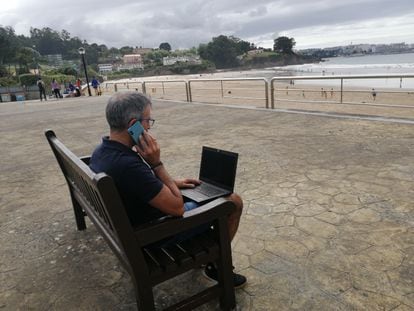Chronic stress and endless hours: Were we ready to work from home?
When the Covid-19 pandemic hit, many businesses were unprepared to make the switch to remote working, leaving staff with a range of health and social problems
/cloudfront-eu-central-1.images.arcpublishing.com/prisa/A2YOP3GSVNCNNN6GYTVGI3ULKQ.png)
In the middle of March, offices across Spain were emptied of staff and were filled with uncertainty. Seven out of every 10 Spanish firms sent either all or at least part of their workforce home, according to a recent survey. More than three million people worked from home during Spain’s coronavirus lockdown, which was one of the strictest in the world. That is four times more than the usual 4.8% of employees in the country that usually carry out some of their tasks remotely during part of their work week.
The immersion into home working due to the Covid-19 health crisis was rash to say the least. Workers went from their offices one day to their dining rooms the next, trying to hold Zoom meetings while their children played in the background. Companies had to try to find laptops in record time, with the country closed, as well as setting up secure platforms and organizing remote tasks that were previously carried out in person, explains Rosa Santos, the director of labor relations at Spain’s biggest employers’ association, the CEOE. Nearly five months later and with outbreaks rising, the government recommendation to prioritize home working is still in place.
Around half – 41% – of Spanish companies are planning to continue with the remote-working formula
“We had to quickly adapt to the new methods,” explains Teófila Vicente-Herrero, a specialist in occupational medicine and expert in home working. “Not everyone was prepared and not everyone could move at the same pace,” she adds. The stress of maintaining the usual level of performance in the face of unusual demands, she explains, cause “somatizations, with digestive problems, interrupted sleep and anxiety due to the lack of adaptation to a new stressful situation.” This is more acute among those who have never worked remotely. “There was bad information, as well as a lack of training and technology. All timetables have been interrupted. In many cases people are working unending workdays, and that effects biological rhythms and family and social relationships.”
According to data from NordVPN, a personal virtual private network service provider, people have been working up to two hours extra a day in Europe and three hours in the United States. One in every four employees has had to use their free time to meet their obligations, according to a Eurostat survey, and we have done so from the sofa or from the kitchen, sharing improvised spaces with our partners and/or children. And people’s work has cost them hours of sleep.
“I have had three jobs: homework, remote working and housework”
What has happened after all these months of the situation? “We haven’t adapted, we have assumed that remote working is simply moving the office to your house and that’s it,” says social psychology professor Francisco Díaz Bretones, from the labor relations and human resources faculty at Granada University, in southern Spain. “We are not in control of the situation and we are under chronic stress. There is no respite. We have expanded time and space. If work before was limited to a place and a time, that has disappeared. We’re working under a parasol on the beach, at home, in the office, at all hours. It’s the first thing that we do when we wake up and the last thing we do before we go to bed. We don’t have any time to recover or to rest. Physical recovery is a lot quicker. But psychologically we take a lot longer to return to a state of relaxation.”
Zoom meetings
As the epitome of videoconference platforms, Zoom found a home on many computers during the lockdown. It went from 10 million daily users in December to 300 million at the height of the crisis. The experts point to how hugely useful it has been. “It saves time, you don’t have to travel, it permits non-verbal communication and it works well when you are sharing your screen,” argues Jeremy Bailenson, the founder of the Virtual Human Interaction laboratory at Stanford University. “Without videoconferences, the world would be suffering even more during the pandemic.” Professor Díaz Bretones says that virtual meetings are actually more effective. “We optimize our time better, given that we do away with some of the social contact, and we focus more on the progress of the meeting. And there’s another thing – in a face-to-face meeting, if it drags on or is boring, you have to pay attention. With Zoom you can do other things.”
Anyone who has been making daily videoconference calls, such as teachers who have been forced to use such programs to give classes, will be familiar with what is known as “Zoom fatigue.” Bialenson has just started an ambitious investigation into the phenomenon and explains what happens when meetings consist of a group of heads on a computer screen. “During a face-to-face meeting with a dozen or so people, the time that we spend looking each other in the eye is very short. And when it does happen, it only lasts a few seconds. With Zoom, a meeting with the same number of participants takes place with a grid of faces and each one is looking at you from the screen the whole time. That can help with productivity, but has a cost. People feel very uncomfortable when they are being constantly observed. The brain is particularly attentive to faces, and when we can see them amplified, we interpret them as being very close. Our fight-or-flight reflex responds. During a study we did at Stanford [University] we found that when you are exposed to very large virtual faces, you physically shrink. This can partly explain why Zoom is so exhausting. Every minute that we are in a video conference call we have faces that look at us just centimeters from our own.”
Video conference calls have arrived in our work lives without any sign that they will be going any place soon. As such, argues Eva Rimbau, a professor in human resources and organization at the Oberta University of Catalonia (UOC), meetings need to be rethought out when some participants are in the office and others aren’t. “You have to approach it as if everyone was outside, because if not, those who are together physically take control,” she explains. “The meeting is theirs and they forget about those who are absent. Now is the time for us to learn this.” And, she adds it’s also the time to strengthen “asynchronous communication, with tools that allow for us who are not connected at the same time to respond, with one person leaving their information and another finding it later.”
There are also tricks to alleviate the fatigue caused by virtual meetings. One of the obvious ones, which has been cited many times, is to disconnect the camera so that we are not constantly looking at each other. Another suggestion comes from Professor Bailenson. “One of my weekly meetings lasts two hours,” he explains. “After the first few that we did, which left us exhausted, we decided that only the person speaking would appear on the screen. It helped. For our cats and dogs or our furniture to appear constantly is not crucial for the majority of meetings. Zoom also allows you to control the position and the size of the windows that show the faces of another participants, so you can play with the settings. You can also install a webcam so that your image appears close in the screen but you can sit further from the computer.”
Lack of work-life balance
“We have suddenly lost the workplace, a social protection, and you go back to a loneliness that isolates you from that culture of coffees and conversation, which brings you together,” says the psychiatrist Enrique García Bernardo. “In the long term, we don’t know what the consequences will be. You need to be a certain way to deal with the self-absorption that is needed for writing or art. It can even be a threat if your work is not creative.” He points out that a large part of our social surroundings stem from our work environment. A classic risk of home working is isolation and the depressing consequences that this can bring with it.
Is this how home working should be? No, say the experts. Eva Rimbau believes that this is an exceptional situation. “Our children stopped going to school, our family or us ourselves have fallen sick, we couldn’t go out. So many things have changed for the worse…” she says. “We can’t reach any more conclusions apart from to say, is homeworking in the case of a crisis a nightmare? Yes. We are very tired, and how we feel at the moment is not representative of how we could feel with a normal remote-working job.” Rosa Santos from the CEOE says the same thing. But, she adds, staff do not want to return to their places of work. “It’s a mix of fear and of appreciating the power to juggle work and life thanks to working from home.”
As well as the loneliness of the home worker, there is another issue: if you are not in the workplace, no one sees you. “In companies where some work from home and some don’t, home workers got fewer promotions, less training and less feedback on their performance,” explains Rimbau, “because they are more out of sight. And that is a danger that exists.”
Home working is now a much more tangible reality. Social media platform Twitter has given its employees this option permanently. Facebook is planning for half of its workforce to work remotely in five years. Google will not have employees in its offices until mid-2021. In Spain, some companies, such as ING, will give staff the option to remote work on a completely flexible basis. Around half – 41% – of Spanish companies are planning to continue with the remote-working formula. And 30% of employees could do so, according to calculations by the Bank of Spain. But it will be different. The government is finalizing a draft law that it has negotiated with unions and businesses to regulate the practice, and this will include the option of home working on a voluntary basis with flexibility, as well as the right to disconnect.
English version by Simon Hunter.


/cloudfront-eu-central-1.images.arcpublishing.com/prisa/OU4F7YO2LQLTG5ABQRTZH6I2V4.jpg)










































